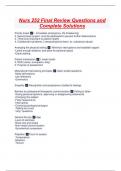Exam (elaborations)
Nurs 252 Final Review Questions and Complete Solutions
- Course
- Institution
Priority levels 1. Immediate (emergency, life threatening) 2. Second level (urgent, must be addressed to prevent further deterioration) 3. Third level (important to patient health) 4. Collaborative problems ( interprofessional team, ex. substance abuse) Arranging the physical setting - Minimize in...
[Show more]



